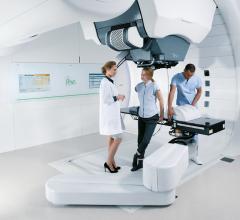August 20, 2007 - Operating under the same tracking principles as a global positioning system, the Calypso 4D Localization System, a GPS for the Body, is now available from PENN Medicine’s Department of Radiation Oncology, offering cancer patient's real-time tracking of the prostate gland during radiation treatment with IMRT or intensity-modulated radiation therapy.
The Calypso 4D Localization System works just like a GPS tracking system but for the prostate. It allows for continuous monitoring of the prostate gland during treatment. Three miniature electromagnetic sensorsveach, no bigger than a grain of rice, are implanted into the prostate during a brief outpatient procedure. Called Beacon transponders, these micro mini transmitters monitor the position and motion of the prostate in real-time, continuously sending signals to a receiver in the radiation treatment room. Before each treatment, the Calypso seeks out the "beacons" and helps the technologist to re-align the treatment plan. This system is reportedly the only one to offer "real time tracking" which helps improve the accuracy of delivering radiation.
As of now, the Calypso System is only FDA approved for prostate cancer and the first patient was treated this May.
For more information: www.med.upenn.edu


 July 09, 2024
July 09, 2024 








